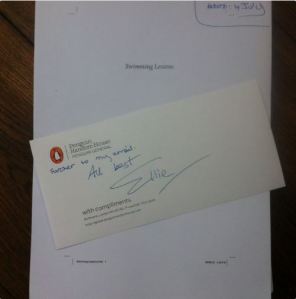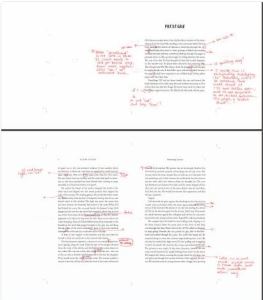I read an article recently in The Guardian about how the UK and US versions of Cloud Atlas by David Mitchell have large sections which are different to each other. Mitchell is quoted as saying he ‘didn’t go to the trouble of making sure that the American changes were applied to the British version (which was entering production by that point probably) and vice versa’. To be honest I wasn’t that surprised.
I have just come to the end of about four months of checking copy edits and making proofreading decisions for my novel, Swimming Lessons which will be published early in 2017. The work calls for precision, meticulousness and reading the whole book somewhere between ten and twenty times, and that’s after the main edits have been signed off.
For me, the issue is complicated because I have different publishers in both countries: Fig Tree, an imprint of Penguin in the UK, and Tin House in the US. And both publishers have their own schedules, their own ways of doing things, their own style guides.
Juliet Annan, my editor at Fig Tree, passes copy editing and proofreading management to a Penguin Editorial Manager, while at Tin House, this process is managed by my editor, Masie Cochran (although both publishing houses use an external copy editor and proof readers).
Fig Tree bought Swimming Lessons first and consequently its publishing process started and ended sooner than Tin House’s, which meant that I wasn’t able to work on the text for both countries at the same time.
You might think copy editing and proofreading would be as simple as checking for errors and changing British English spelling and phrases to US English spelling and phrases. But writing and editing books is never that easy. Swimming Lessons is set in England, and I am an English author, so quite rightly Masie didn’t think for example that ‘pavement’ should be changed to ‘sidewalk’, or even ‘colour’ to ‘color’. (Although a fellow author who wrote a book set in England told me that her US editor did want her to change ‘pound’ to ‘dollar’. She resisted.)
This is the process:
- I work with my editors to make the book as good as it can be in terms of structure, plot, character; all those things that make a novel a novel
- The manuscript is sent to a copy editor who feeds back changes which I work on or reject (with the editor getting involved in major decisions)
- The manuscript is laid out as a book
- The book is sent to two proof readers
- The copy editor (in the UK) or Masie (in the US) checks the proof readers’ changes
- I’m sent a print out of the book on A4 paper (UK), or a pdf (US)
- I accept or reject the proof readers’ changes (involving the copy editor or Masie in any large decisions) either actually on the page, or in a Word document
As I write this list of actions, it still sounds simple. But there are up to 10 changes per  page in a novel that’s approximately 307 pages long, with over 86,000 words. And the changes made by the UK will often be completely different to those made by the US.
page in a novel that’s approximately 307 pages long, with over 86,000 words. And the changes made by the UK will often be completely different to those made by the US.
And because of the different publishing schedules, I don’t work on just one document for both countries; I work on two. The UK copy editing and proofreading changes for Swimming Lessons were finished and approved (or not) by me a few months ago, while I finished the work for Tin House earlier this week. Penguin’s copy is ready to go to print. It is up to me to decide which of the changes we incorporated in the UK version should get transferred to the Tin House copy and vice versa. Of course, it’s easy with spelling mistakes and major inconsistencies, but what about the grammar? Commas go in, and commas come out; colons change to semicolons and back again; speech marks are double or single, titles of books are italicised or they’re not…
But it’s also not just up to me. There are the style-guides to remember. These are documents the publishing houses use to create consistency across their own books. Interestingly, Penguin’s style-guide even for UK books mandates the use of z’s: realize, recognize, authorize. But because Masie and I decided that Swimming Lessons is an English book by an English author, we’ve used realise, recognise and authorise. So oddly, the book will have some US spelling in the British version, and some UK spelling in the American version.
The copy editor and proof readers at Tin House also use the Merriam-Webster dictionary for clarification. So, the UK version will have ‘sing-song’, whereas for the US version Merriam-Webster suggests ‘singsong’; and it’s up to me whether to agree that change or not. What about ‘candlestick maker’ or ‘candlestickmaker’, ‘mid-sentence’ or ‘midsentence’, ‘fish-like’ or ‘fishlike’? And on and on.
Luckily I enjoy dealing with this level of detail. (I prefer editing to writing a first draft.) But my spelling and knowledge of grammar is poor. When I’m deciding what changes to accept and which to reject, or ‘stet’, I try to consider clarity, consistency, syntax, (my) style, and rhythm before I think about whether the grammar is correct. (I rejected every ‘whom’ where it would have been technically correct in favour of the ‘who’ that I wrote.) And my overall objective when we’re down this deep in the text is to create words, and sentences and paragraphs that keep the reader reading.
If you’re a writer, let me know how copy editing and proofreading works for you, and if you’re a reader, did you know this already? I’d love to hear what you think.
But if you do read Swimming Lessons when it’s published and you spot any typos or grammatical errors, actually I don’t want to know.

Claire that is a lot of juggling. I’m on the 10/20 edit of my first novel ‘Northern Branches’ and I too struggle with grammar etc and I tend to over describe body movements in particular so condensing is the name of the game. I love that your main objective is to keep the reader engaged, this seems simple but when you’re trying to juggle all the elements of the story and keep POVs realistic and settings clear and actions suitable for each character – writers could easily forget that it’s to create a fine rockin’ story that makes the reader want to keep picking up your book.
To be very honest I’m so jealous of the relationship you have developed with 2 publishing houses- you show off! (Teasing sorry) Yes it’s definitely frustrating and lengthy but I really can’t wait for ‘Swimming Lessons’ It’s gonna be a cracker as they say in the North! All the very best and thank you for sharing this process so candidly. I can dream now!
LikeLiked by 1 person
There is so much juggling when writing a novel, and then you’ve got to make it look like you haven’t juggled anything to the reader. It’s a tricky thing. Good luck with Northern Branches.
LikeLiked by 1 person
I hate it when American editors Yank all over English books so the motor cars have hoods & women appear in public in pants. Imagine reading Mark Twain rewritten in scouse.
LikeLiked by 2 people
Hah! I’m not sure I’ve read (or been aware of) a US novel being changed to UK English. It only seems to ever happen (sometimes) the other way round.
LikeLike
I don’t understand why UK authors allow American editors to muck about with their prose. Makes me feel they think we Yanks are ignorant provincial boors. Ruins the flavour too.
LikeLiked by 1 person
I wish that they would leave the author alone! We readers are smarter than they think!
LikeLiked by 1 person
Hah! But sometimes we need a little help…
LikeLiked by 1 person
This is fascinating Claire. A great post. I’ve learnt/learned loads 😉
LikeLike
Oh God, learnt and learned, burnt and burned…I never know which is should be. Glad you enjoyed it though.
LikeLike
So interesting – thanks for posting, Clare. Looking forward to reading ‘Swimming Lessons’!
LikeLiked by 1 person
Thanks Elizabeth.
LikeLike
Thanks for this Claire, I am on No.1 of your process with my editor (at Little, Brown) and didn’t really know what was coming next, so this was v useful!
LikeLiked by 1 person
Good luck with it Laura. Of course other publishers might work in different ways, and it would be interesting if you’d come back and say if it was different, when you’ve finished.
LikeLike
Thanks Claire, be glad to. Am actually sort of looking forward to making decisions about commas etc rather than struggling with plot holes!
LikeLiked by 1 person
Pingback: Flash Fiction: A stolen heart | Claire Fuller
I’m not sure that Americans would want Jane Austen translated into American; I wouldn’t want Hemingway translated into English English.
And as for the Oxford comma, well….
Looking forward to learning how to swim.
LikeLiked by 1 person
All good observations! And, thanks.
LikeLike
Pingback: Flash Fiction: A stolen heart — Claire Fuller | Arrowhead Freelance and Publishing
Pingback: To stet or not to stet – Occupational Therapy Research